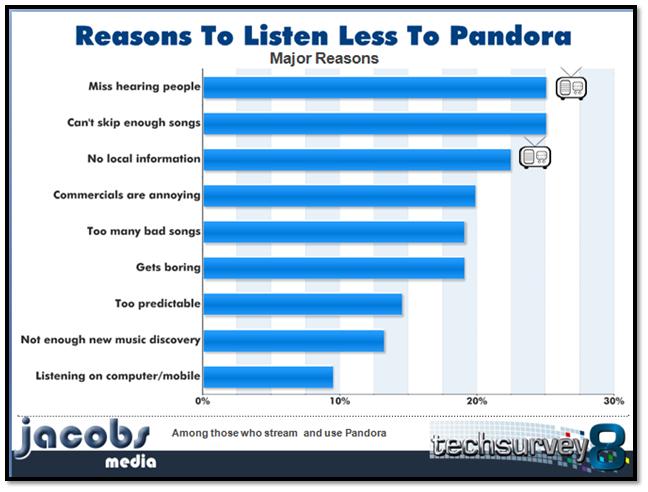 Techsurvey8 dedicated a number of questions to better understanding the Internet environment among the radio listening community. And to no one’s surprise, Pandora has a huge lead over everyone else in the pure-play world.
Techsurvey8 dedicated a number of questions to better understanding the Internet environment among the radio listening community. And to no one’s surprise, Pandora has a huge lead over everyone else in the pure-play world.
While well more than 40% of those who stream listen to Pandora, only 5% say they tune in Slacker. And they’ve been around since 2007.
So what do you do when you’re a fledgling Internet brand up against Pandora? Just like in the broadcast radio environment, you have to be different.
Songza is an interesting product that allows you to choose your mood and your listening situation. Their “concierge” service cleverly puts together a playlist on those dimensions, as opposed to Pandora artist/song algorithm.
That’s their difference. So for Slacker, what sets them apart from everyone else?
DJs.
That’s right. Former broadcast radio guy Mat Bates, and now Slacker’s senior radio program manager, was interviewed by Kurt Hanson at a special edition of RAIN at Conclave a couple weeks back.
It was a revealing look behind the scenes at what goes on at an Internet radio brand trying to become a bigger fish. Bates told the room that many of broadcast radio’s best practices apply to pure-plays, too. He admitted that while broader than typical FM stations, Slacker has tightened up their music.
So Slacker is going the DJ route, and they’re also using broadcast radio PDs to shape and program many of their channels. It’s an interesting experiment to be sure, and it begs the question: “Are human guides additive to the customer experience in the pure-play space?”
This made me think of the list of key Pandora weaknesses, right out of Techsurvey8. Aside from not being able to skip enough songs (and only a tiny minority is willing to pay for Pandora One with almost unlimited skips), the biggest Pandora negatives are the absence of people on the radio, and the feeling of being disconnected to a local community when listening.
Slacker isn’t going to solve the hometown problem, but they are looking to DJs to be a difference-maker. As Bates averred, “We are human beings – not robots.” And for Slacker, it’s their way of creating a clear-cut difference. Looking at the chart below, they may be right.
Are you aware that a number of broadcast radio PDs actually program Slacker channels? Bates named a couple of names, but also indicated that others had to remain anonymous – for obvious reasons.
First, it’s interesting that here’s a pure-play using the talents of broadcast radio PDs to mold and shape its channels. And second, why would any company allow its programmers to moonlight anywhere – much less a pure-play company whose mission is to erode broadcast shares and brands?
Be that as it may, it is interesting that Slacker is taking a few pages right out of the broadcast radio playbook from the hiring of PDs to the use to DJs to the presence of Bates himself. In the meantime, Pandora continues to pilfer former broadcast radio salespeople. Both companies are focusing on doing what broadcast radio stations and brands have been doing all along.
So it makes you wonder why more traditional radio companies simply don’t study these pure-play competitors – what’s working and what’s not – and then re-dedicate their efforts to what made broadcast radio successful in the first place: the best local, personalized, and warmest music experience possible.
And when you think about it, broadcast radio has a 50 year head start. As pure-plays like Slacker invest time, money, people, and resources toward attempting to replicate an experience that many AM and FM stations have been presenting for decades, it makes sense for broadcasters to work hard to maintain the best quality personality experiences.
Yes, hiring, training, and cultivating great DJs and dedicated brand managers is a significant expense. It requires talent, great managers to guide them, and smart promoters to market them. But it will also be expensive to lose shares to pure-play competitors still struggling to get the broadcast radio formula right. Slacker is moving down this old school road because they think it’s smart.
Now more than ever, broadcast radio needs to do with it has always done best .
It’s time to stop slacking.
- Can Radio Win “The Last Touch/First Touch Challenge?” - April 4, 2025
- How Will Radio Fare In The Battle For The Fourth Screen? - April 3, 2025
- Like A Pair Of Old Jeans - April 2, 2025





I program a Slacker station. Give me wonderful insight into what an ENTIRE, sizable group of listeners wants, hates, skips, etc. The research is comprehensive of every listener–not the small smaple you get in call out or auditorium testing.
More than anything, it makes me laugh at programming to PPM. When interactive radio can see the listening habit of EVERY listener (and are expected to provide the most robust curation possible), how does terrestrial radio possibly provide more responsive radio, catering to 10 PPM holders?
Sky, thanks for the comment and perspective. And you’re right – the very best stations don’t program to the meters. They build brands even if it breaks so-called PPM Rules. Thanks for bringing us your POV.
PPM isn’t even in our vocabulary at WRLT. As a quaint AAA station in Nashville, we program music to and interact directly with a loyal, mostly local audience. The consumers of the brand we’ve built over the years know exactly what to expect from us: constant new music discovery, education about the music they’re hearing via live local jocks, current information, and on-going community involvement. And oddly enough — they like it! Oops!! Looks like we’ve been breaking a lot of PPM Rules here!!
Sarcasm noted, Fred. Congratulations and building a great brand and thanks for taking the time to comment.